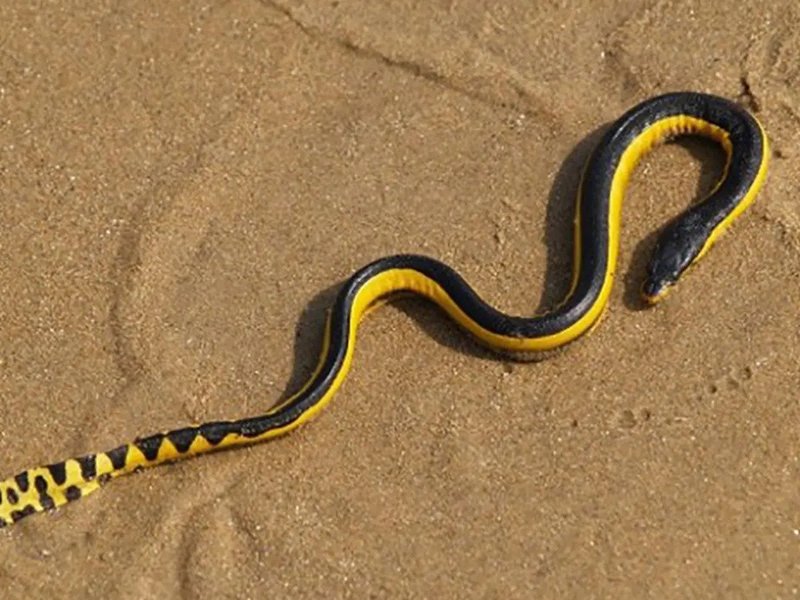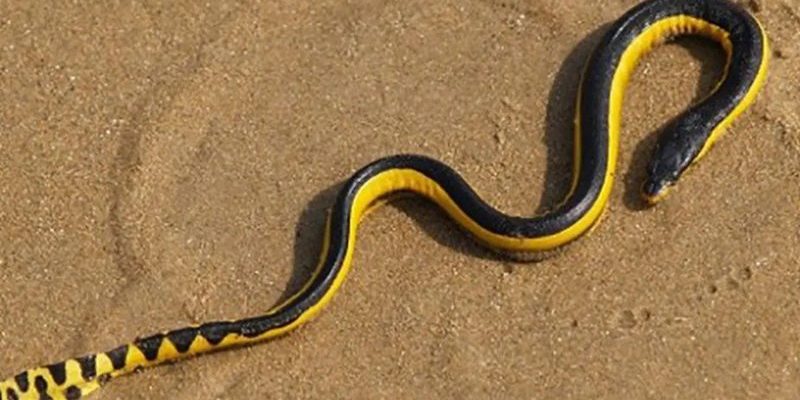
The Yellow-Bellied Sea Snake is one of those creatures that seems to glide straight out of a storybook. Picture a long, slender body, painted with bright yellow along its belly and a striking black or dark gray on its back. It’s like nature decided to play with colors, creating a snake that’s both beautiful and fascinating. But there’s more to this spectacular reptile than meets the eye. Its life at sea is different from what many snakes experience on land, and understanding its habitat, diet, and habits can truly open up a new world of appreciation for these remarkable creatures.
You might be wondering what sets the Yellow-Bellied Sea Snake apart from other sea snakes. Well, it’s not just its eye-catching colors. This species is known for its incredible ability to thrive in the ocean, where it hunts for food and navigates vast distances. Living primarily in the warm waters of the Pacific and Indian Oceans, this snake has adapted to a lifestyle that is uniquely aquatic. It’s the ultimate example of how an animal can adapt beautifully to its environment.
Physical Characteristics
The physical appearance of the Yellow-Bellied Sea Snake is quite striking. Typically, they can grow up to about 3.5 feet long, though some individuals have been recorded at over 4 feet! Their elongated bodies are designed for smooth swimming, with a flattened tail that works like a paddle to help them glide through the water. The color contrast between their dark dorsal side and bright yellow belly not only makes them look stunning but also serves a purpose: it helps with camouflage. This unique coloration can confuse predators and prey alike, making them less visible in the shimmering ocean depths.
Their skin is covered in small, smooth scales, and this sleek texture is perfect for cutting through the water. An interesting fact is that the Yellow-Bellied Sea Snake has a pair of small, round eyes with vertical pupils, giving it excellent vision underwater. You might think this snake is all about looks, but its vibrant colors are also a warning sign to potential predators. The brighter the belly, the more venomous the snake! Yes, this sea snake is indeed venomous, although it typically poses little threat to humans.
Interestingly, these snakes have a specialized gland that helps excrete salt, allowing them to live comfortably in ocean water. This adaptation is essential since they spend most of their lives in saltwater environments. Their bodies are designed for life at sea, showcasing the incredible ways wildlife can evolve to survive and thrive in their habitats.
Habitat and Distribution
The Yellow-Bellied Sea Snake is primarily found in tropical and subtropical oceans, preferring warm waters where it can easily find food. You’ll mostly spot them in the Indian Ocean and the western Pacific, including areas around the coasts of Australia and Southeast Asia. They often inhabit coastal waters but can also venture out into deeper territories. This adaptability allows them to take advantage of different ecosystems, whether near shores or further out at sea.
These snakes are often seen floating on the surface of the water, where they spend a lot of their time basking in the sun or resting. They are known to drift with ocean currents, which helps them cover large distances without expending a lot of energy. This behavior is quite fascinating—you could say they take the lazy river approach to life!
In terms of breeding grounds, they tend to seek out areas with plenty of food, like schools of fish or other marine creatures. They don’t have a specific breeding season, which is quite unique. Instead, female Yellow-Bellied Sea Snakes can give birth to live young, often in shallow coastal waters. This strategy maximizes the chances of survival for the young snakes, allowing them to quickly adapt to their environment.
Diet and Hunting Techniques
The diet of the Yellow-Bellied Sea Snake consists mainly of fish and eels. They are skilled hunters, using their excellent eyesight and fast swimming skills to catch prey. You might be surprised to learn that these snakes can stay submerged for a long time, often diving up to 300 feet in search of food. Their hunting technique involves a combination of stealth and speed—sneaking up on their prey before striking with precision.
When it comes to feeding, these snakes have a unique ability to consume fish that are quite slippery and fast. What makes them stand out is their ability to swallow their prey whole. They possess specialized jaws that allow them to open wide enough to accommodate their catch. Once they’ve snatched a meal, they will often retreat to a safe spot to consume it, avoiding potential predators that might be lurking nearby.
Another interesting aspect of their diet is that the Yellow-Bellied Sea Snake has a relatively slow metabolism. This means they don’t have to eat frequently, which is helpful since food sources can sometimes be scarce in the vast ocean. They tend to eat when food is available, sometimes having large meals followed by periods of fasting. This adaptability in their hunting and feeding practices helps them survive in various environments.
Behavior and Social Structure
When it comes to behavior, the Yellow-Bellied Sea Snake is not particularly social. They tend to be solitary creatures, spending much of their time alone in the water. However, during mating season, they may come together in pairs. Interestingly, they are known to be quite curious. Many people have reported seeing them approach divers or swimmers, seemingly checking them out! This curiosity can sometimes lead to interesting encounters.
While they don’t possess natural aggression towards humans, their venom can be dangerous if provoked. Despite this, they rarely bite unless they feel threatened. This is where understanding their behavior can really enhance your appreciation for them—like many creatures in the wild, they prefer to avoid conflict and go about their lives peacefully.
Yellow-Bellied Sea Snakes are also known to exhibit a behavior called “thermoregulation.” They will bask on the surface of the water to absorb sunlight, helping them maintain their body temperature. This is especially important for cold-blooded reptiles like them, which rely on external heat sources to regulate their bodily functions. So, the next time you see one floating lazily on the surface, they might just be soaking up those rays!
Reproduction and Lifespan
Reproductive strategies for the Yellow-Bellied Sea Snake are just as fascinating as their other traits. Unlike many reptiles that lay eggs, these snakes give birth to live young. The gestation period can be quite variable, often lasting between six months to a year. Females will typically give birth to about 3 to 10 young at a time, depending on their size and overall health. This live-bearing method gives the young snakes a better chance of survival, as they are already adapted to life in the ocean.
Once born, the young snakes are independent and must fend for themselves right away. They are small versions of their parents, sporting the same striking coloration. Their immediate challenge is to find food and navigate the ocean safely. As they grow, they will gradually increase in size and start exploring different habitats, which allows them to adapt and thrive in various conditions.
Conservation Status
Like many marine creatures, the conservation status of the Yellow-Bellied Sea Snake is a topic of concern. As of today, they are classified as “Least Concern” by the IUCN, which means they are currently not facing significant threats to their survival. However, this doesn’t mean they are entirely safe. Habitat loss, pollution, and climate change are all factors that can impact their populations. The oceans are changing rapidly due to human activities, and this can have unforeseen consequences for marine life.
Conservation efforts are essential to ensure that these beautiful snakes can continue to thrive in their natural habitats. Protection of coastal areas and reducing pollution in oceans are steps that can help maintain healthy ecosystems for the Yellow-Bellied Sea Snake and many other marine creatures. You might not see these snakes often, but their presence indicates a healthy marine environment, and that’s something worth protecting.
There’s also a push for more public awareness about the importance of marine biodiversity. Understanding creatures like the Yellow-Bellied Sea Snake can help foster a deeper appreciation for the beauty of our oceans and the need to preserve them. After all, these unique animals play a crucial role in their ecosystems, so let’s work to keep them thriving!
FAQ
What is the habitat of the Yellow-Bellied Sea Snake?
The Yellow-Bellied Sea Snake prefers warm, tropical, and subtropical waters, often residing in coastal areas but also venturing into deeper ocean territories. They can be found in the Indian Ocean and the western Pacific, where the water temperature suits their needs for survival. Typically, they are seen floating at the water’s surface, taking advantage of ocean currents to help them move.
How venomous is the Yellow-Bellied Sea Snake?
This snake is indeed venomous, but it rarely poses a threat to humans. Its venom is primarily used to immobilize prey, such as fish and eels. While a bite could be painful and potentially harmful, most interactions with humans are friendly, and bites are uncommon. These snakes prefer to avoid danger whenever possible!
What does the Yellow-Bellied Sea Snake eat?
The diet mainly consists of fish and eels. They are skilled hunters, diving deep into the ocean to catch their prey. They can consume fish whole due to their specialized jaw structure, allowing them to tackle slippery meals effectively. Their feeding strategies highlight their adaptability in a challenging environment.
How does the Yellow-Bellied Sea Snake give birth?
Unlike many other snakes that lay eggs, the Yellow-Bellied Sea Snake gives birth to live young. Typically, the female will give birth to 3 to 10 baby snakes after a gestation period of about six months to a year. This unique reproductive strategy helps increase the chances of survival for the young snakes in their aquatic environment.
How long can a Yellow-Bellied Sea Snake live?
In the wild, the Yellow-Bellied Sea Snake can live for about 10 years, although some individuals may live longer under optimal conditions. Various factors, such as food availability and predation risks, can affect their lifespan, contributing to the challenges they face in the changing oceanic environment.
Are Yellow-Bellied Sea Snakes social animals?
Generally, they are solitary creatures, preferring to live alone rather than in groups. They do come together during mating seasons, but for the most part, they enjoy their independence. This behavior helps them focus on hunting and navigating their environment without the complications of social interactions.
How does the Yellow-Bellied Sea Snake regulate its body temperature?
Like other reptiles, the Yellow-Bellied Sea Snake is cold-blooded, meaning it relies on external heat sources to regulate its body temperature. It often basks on the water’s surface to absorb sunlight, which is vital for maintaining its bodily functions. This behavior is essential for energy conservation, especially considering their lifestyle in the ocean.
Can the Yellow-Bellied Sea Snake swim well?
Absolutely! The Yellow-Bellied Sea Snake is extremely well-adapted for swimming. Its long, elongated body and flattened tail allow it to navigate through water with grace and speed. They can also dive deep to hunt for food, showcasing their incredible swimming abilities. Watching one glide through the water is like witnessing a work of art in motion.
What conservation efforts are in place for the Yellow-Bellied Sea Snake?
Currently classified as “Least Concern” by the IUCN, the Yellow-Bellied Sea Snake still faces threats from habitat loss and pollution. Conservation efforts primarily focus on protecting coastal habitats, reducing marine pollution, and increasing awareness about marine biodiversity. Ongoing initiatives aim to maintain the delicate balance of their ecosystems and ensure that these unique creatures continue to thrive for future generations.

